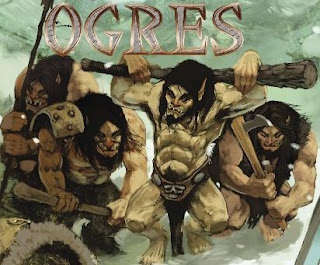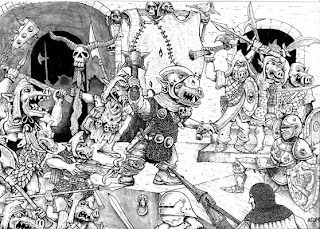OGRE GROUPS

Ogre gangs (3 to 4 ogres) and bands (5 to 8 ogres) appear considerably braver than a lone ogre. They rarely retreat from battle, sometimes concentrating their strength against a single foe, and sometimes even attacking groups that display numerical superiority.
As with a lone ogre encounter, encounters with a gang or band typically start out with a display of force. The ogres scream, beat their chests and launch javelins at their potential target. They hope to intimidate the opposing group into submission; if the targets do not immediately surrender the ogres follow the display with a sudden and ferocious assault.
Ogres do not appreciably alter their tactics when they fight in groups. Each ogre chooses a separate opponent and charges. They strike and then move, hoping to lure their targets into provoking attacks of opportunity. However, they rarely display the presence of mind to layer their threatened areas or engage in baiting tactics. Nor, fortunately, do they tend to bulrush or grab smaller opponents to push them though other ogres threatened areas. This lack of co-ordination means that they spread their damage out rather than quickly crippling a single target. This in turn leads to the target group being able to apply significantly more of their abilities, over a longer period of the conflict than would be true if the ogres actually co-ordinated their attacks.
During the assault the first difference between a single and a group ogre encounter manifests itself. Ogres in a group do not back down from combat. They fight with almost amazing zeal, slaughtering and being slaughtered without regard for their own lives. This happens in part because rage is infectious; as each ogre gets angry the other ogres around him become even more enflamed. Ogre culture plays an equally large part in this change of behaviour. Ogres do not want to appear weak before one another, as doing so could throw their social relationships out of balance. Therefore they refuse to back down from a situation that, alone, they would happily run away from.
Ogre groups will generally not exhibit enough coherence to accept surrender after they engage. They also tend to kill everyone they knock down. After all, great battles deserve great feasts.
Fortunately ogre groups do not demonstrate any great dedication in pursuit. Much as with a single ogre encounter, the group will break off the chase as soon as it becomes apparent they will not immediately catch their prey.
If the group is defeated and allowed to live, each individual ogre will try to make what tribute it can. It is possible, although extremely dangerous, to take an entire band of ogres into service this way. Doing so opens up the master’s constant struggle of maintaining dominance over not just one ogre, but over however many survived.
Ogre Group Key Tactics
Ogres in groups use the following tactics:
+ So long as there are more targets than ogres, each ogre will attack a separate target.
+ If there are fewer targets than ogres, ogres spread their attacks around as evenly as possible.
+ Ogres in a group do not flee from combat. The last ogre standing may attempt to flee if he still retains a significant number of his hit points.
+ Ogres do not generally aid another when making Intimidate checks.
+ Ogres do not position themselves to maximise ‘drag through’ attacks of opportunity.
Ogres in Service
Ogres in service to a stronger creature do not suddenly develop a better sense of tactics or strategy. They are just as vain, disorganised and personally unwilling to co-operate as ever. However, they do follow orders when it looks like failing to do so will result in even greater punishment later on. When the battle is going reasonably well and the ogres’ master remains reasonably undamaged the ogres will follow whatever order of battle the master established. This order of battle can include ambushes, tactical withdrawals and even co-operative battle tactics. Furthermore the ogres will obey direct orders without hesitation. If the tide of battle turns against the ogre’s master but the master remains unharmed, the ogres will continue to obey orders. Once the master becomes embattled, however, the ogres begin to look at him for signs of weakness. When it becomes clear that the ‘master’ will go down in defeat any servant ogres will immediately attempt to flee. They only hesitate if it they see an obvious opportunity to bring the ‘master’ down.



Comments
Post a Comment